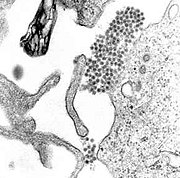| Dengue virus | ||||||||
|---|---|---|---|---|---|---|---|---|
 | ||||||||
| Virus classification | ||||||||
|
Friday, August 14, 2009
Dengue Virus
Treatment
The mainstay of treatment is timely supportive therapy to tackle shock due to haemoconcentration and bleeding. Close monitoring of vital signs in critical period (between day 2 to day 7 of fever) is critical. Increased oral fluid intake is recommended to prevent dehydration. Supplementation with intravenous fluids may be necessary to prevent dehydration and significant concentration of the blood if the patient is unable to maintain oral intake. A platelet transfusion is indicated in rare cases if the platelet level drops significantly (below 20,000) or if there is significant bleeding. The presence of melena may indicate internal gastrointestinal bleeding requiring platelet and/or red blood cell transfusion.
Aspirin and non-steroidal anti-inflammatory drugs should be avoided as these drugs may worsen the bleeding tendency associated with some of these infections. Patients may receive paracetamol preparations to deal with these symptoms if dengue is suspected.[8]
[edit] Traditional and emerging treatments
Emerging evidence suggests that mycophenolic acid and ribavirin inhibit dengue replication. Initial experiments showed a fivefold increase in defective viral RNA production by cells treated with each drug.[9] In vivo studies, however, have not yet been done. Unlike HIV therapy, lack of adequate global interest and funding greatly hampers the development of treatment regime.
In Brazilian traditional medicine, dengue is treated with cat's claw herb, which is for inflammation and does not prevent dengue.[10]
In Malaysia, dengue is treated by some using natural medicine. Mas Amirtha and Semalu developed by the Alternative Medicine Research Institute, Center for Asia.[citation needed] The treatment is speculated to be able to arrest and reverse the viral infection and prevent the disease from advancing into a critical stage, though no evidence has yet shown effectiveness. In Philippines dengue patients use tawa-tawa herbs and sweet potato tops juice to increase the platelets counts and revived the patients.